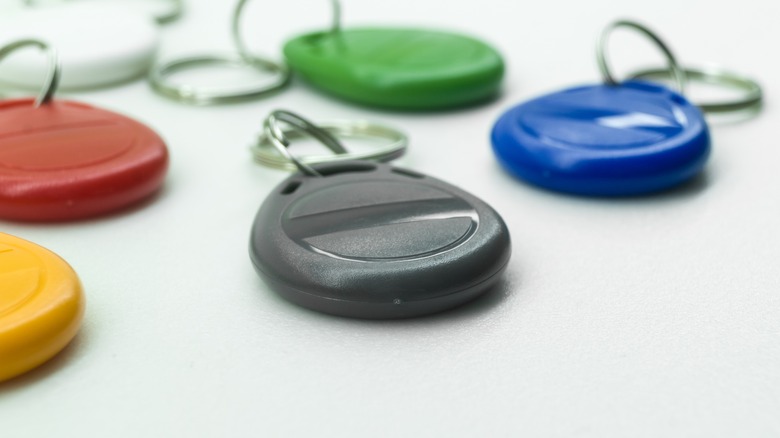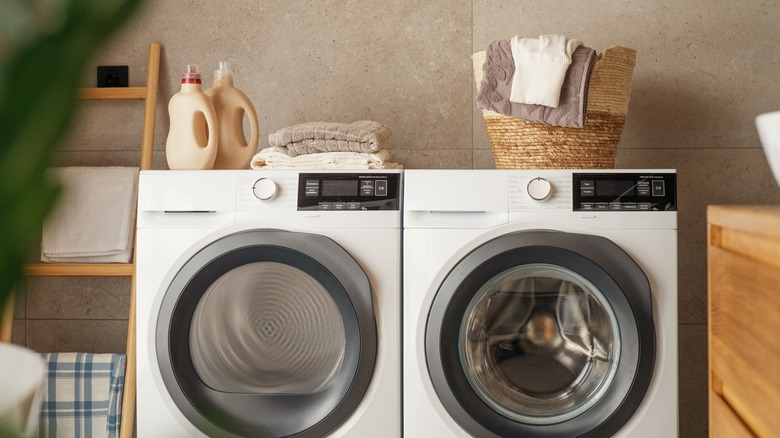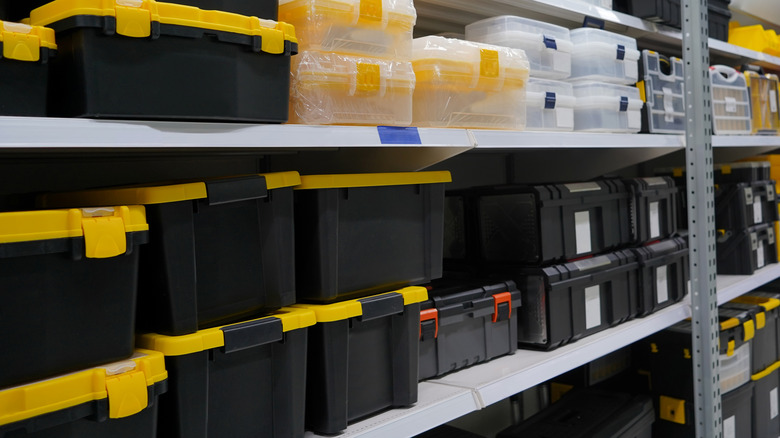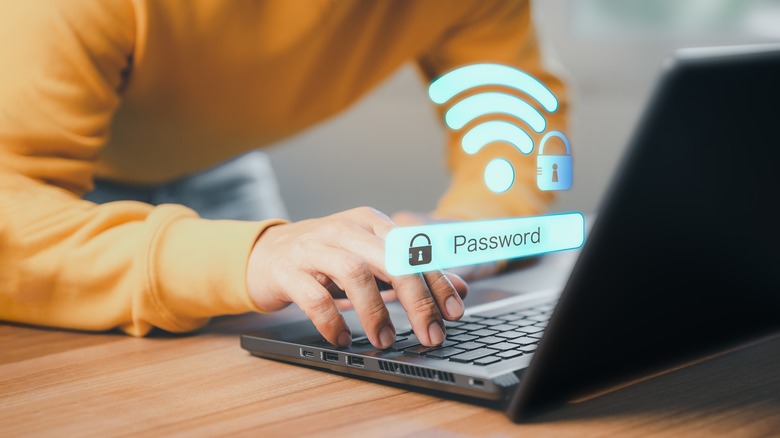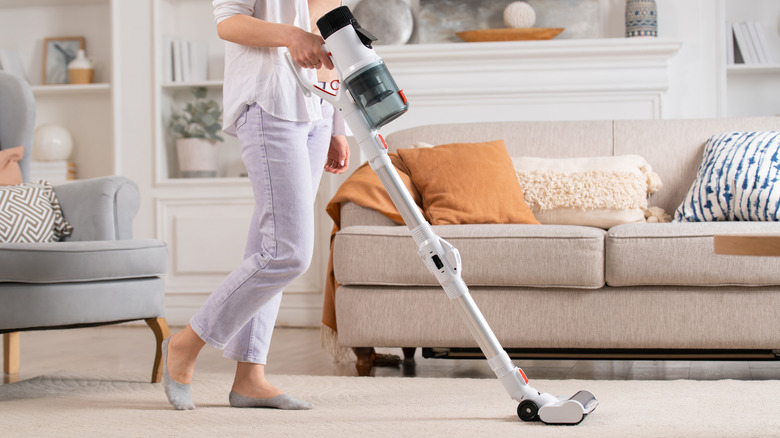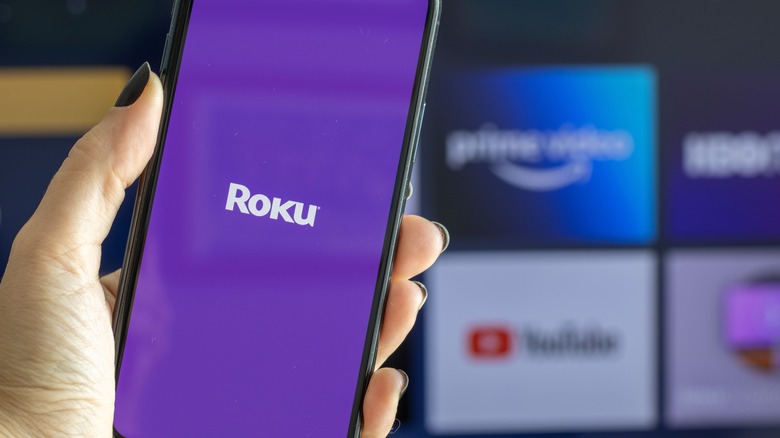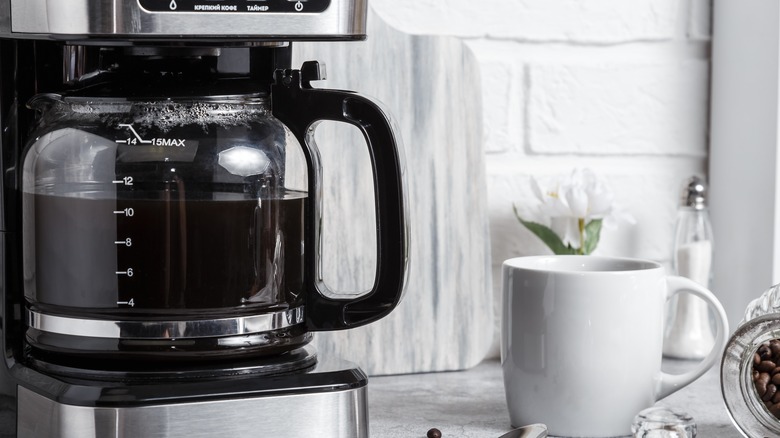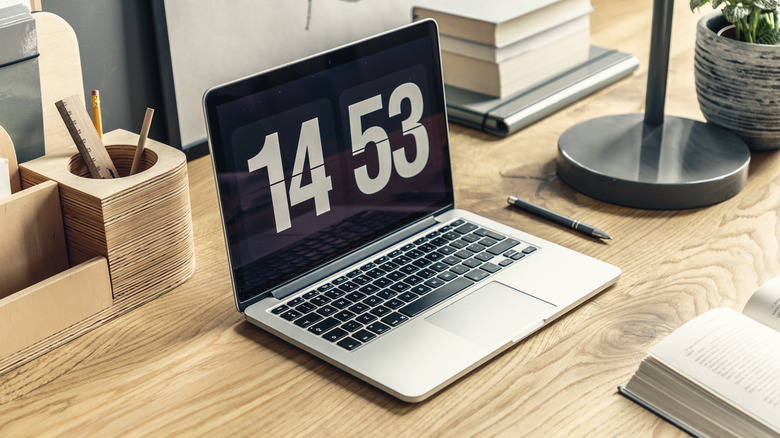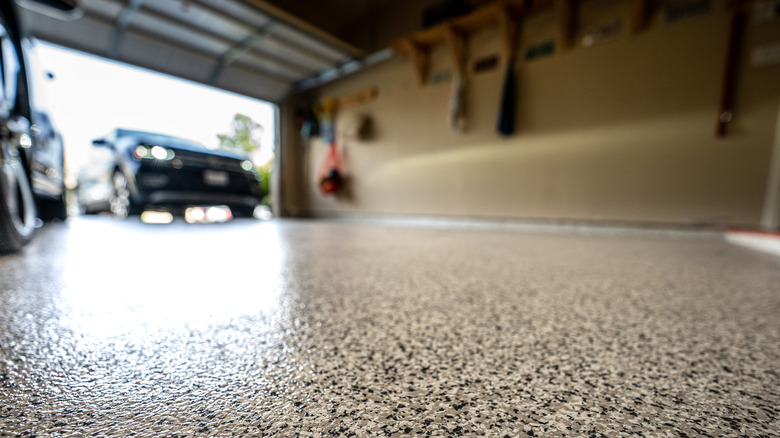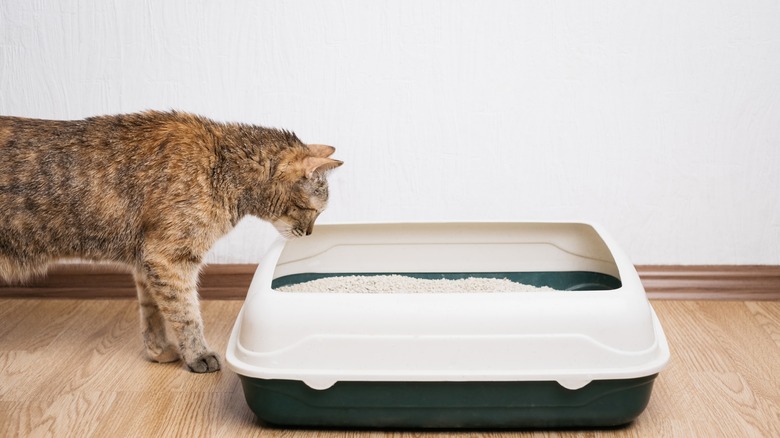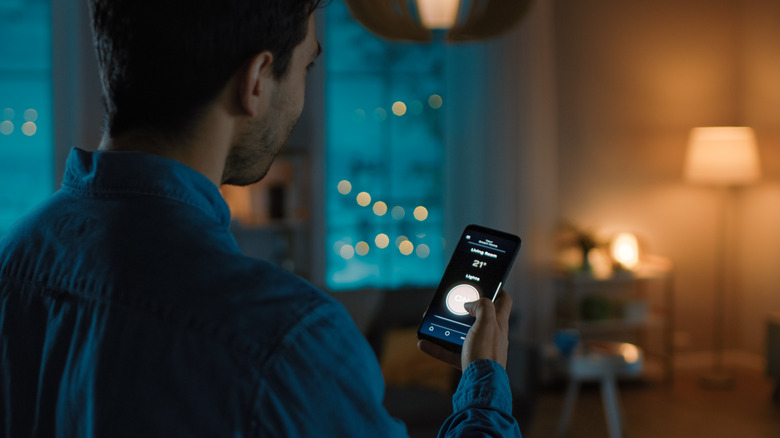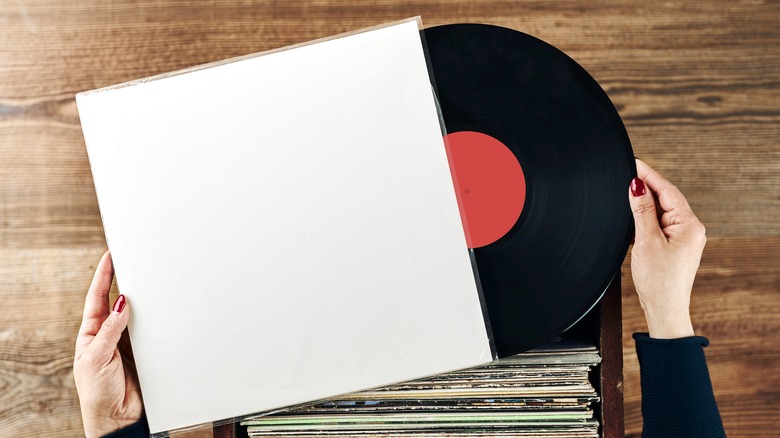The Best Ways To Use NFC Tags In Your Home
If you haven't delved into the world of Near Field Contact — or NFC — tags, you're missing out. It's incredible how much these unassuming little plastic chips are capable of. You most likely first encountered NFC tech through contactless payment systems such as Android, Apple, or Google Pay, or some public transit systems cards. NFC is a relatively new technology that still has miles of potential to grow into, but many people don't know that NFC tags — tiny little chips that store a limited amount of data and communicate over short radio waves — are now available for just a few cents apiece online. You can buy a few dozen or hundreds. It's not accessing this technology, but figuring out all of the different ways to use it, that can be tricky.
Fortunately, an emerging online community is taking the charge of brainstorming new NFC chip applications and putting those ideas to the test. Many NFC tag uses at home don't require anything else but the tag and your smartphone, while some more complex NFC tag ideas need the help of an existing smart home ecosystem and ancillary tech like motion detectors and smart light bulbs. We scoured the internet for the best NFC tricks to use in your home, and the great news is that you can stick to the basic uses to start out, or dive into the more intricate NFC hacks right away.
Washer and dryer timer reminders
Just about any modern washer and dryer is going to have built-in timers, but there are many reasons why you may want a different way to track your laundry's progress. If your laundry is on a different floor of your house — also if you or another household member are hard of hearing — the timer chimes may not be loud enough to hear. NFC tags can send announcements to your phone or your smart home system when your laundry is done. On the contrary, maybe you don't want the loud machine chime to disrupt members of the home, like sleeping babies. You might work from home and don't want important phone calls or conferences to be disturbed by an obnoxiously loud timer. Or maybe you do laundry in a shared space, like a college dorm or an apartment, and are notorious for forgetting about your laundry in the machines. In that case, just pop the NFC chip on your hamper instead of the machines.
You can instruct an NFC tag to start a timer countdown that you choose when you first program the chip. You can pick the amount of time as well as the notification sound or vibration, depending on how you program the tag, which is demonstrated on YouTube.
Catalog boxes/totes/storage
Rifling through your storage totes and looking for something specific gets old very fast. With the magic of NFC tags, you can keep a detailed, itemized list of everything kept in a storage box. You can make things even easier by implementing a color-coordinated system of NFC tags with a pack like these NFC tags on Amazon. Use blue tags for winter gear, green tags for holiday decorations, red tags for important documents and files — whatever customization makes the most sense for your storage.
Reddit has a number of valuable suggestions on how to actually program the chips for this use, with Google Keep and in-house note apps being potential solutions. Just be sure to stick the NFC tag somewhere where it's convenient to easily scan from your phone without pulling down the whole box. This NFC application could prove to be especially useful for foster parents, for example, who may be storing large amounts of clothing and other supplies; the tote NFC chips could be written to detail the sizes and styles of clothes in each tote to reduce rummaging and looking in a time-sensitive situation. It could be especially valuable to be able to search your catalog of tagged totes — for example, needing to find Christmas ornaments and simply searching your database to find which NFC chip has Christmas ornaments on its list. No more lugging a half-dozen heavy boxes out and probably not even finding what you're looking for.
Sharing important details with house guests or house sitters
If you frequently host house guests or baby/pet/house sitters, NFC tags can be a great way to keep important details and instructions easily accessible to your visitors. (Note: for this NFC tag use, purchase tags that can store a bit more data. This helps when you want to share images or blocks of text with the scanner.) Take this hack one step further by affixing your house guest NFC tag to an NFC tag keychain, then loop that keychain with your spare house key.
Store Wi-Fi passwords, streaming service passwords, door or gate codes, pet or child care instructions, addresses and directions, emergency contacts, or just any tidbits that might make a house sitter or Airbnb guest's stay easier — like "be sure to pull on the front door while unlocking!" As far as sharing this information with your visitor, you can either write the text to the tag for the guest to read, take a picture of the information (like a screenshot of a PDF) and import that to the tag instead, or program the NFC to send a text or email with the instructions to the guest when they scan the tag. Just keep in mind that, if you go that last route, you'll need to edit the instructions for the NFC tag every time to update the contact information for your new visitor.
Home chores/cleaning tracking
While you can certainly keep tracking your chores on a whiteboard in your kitchen if you want to, NFC technology has made evolution beyond this possible. There are quite a few ways to approach this, and the best solutions will depend on the following: What you want to track, if you'd rather be reminded to start a chore or log when a chore is done, and what existing smart home assistant and household tracking apps you already have or are willing to get.
A home assistant can send reminders to your phone when an NFC tag associated with a particular chore — vacuuming, cleaning the bathroom, or dusting, for example — has not been scanned. With your home assistant, set the reminder for each chore to your preferred duration, such as vacuuming every three days or dusting every two weeks, and then program the NFC tag to track that reminder. When you start or stop that chore, simply tap the NFC chip and the reminder will reset.
Another valuable application of NFCs related to home chores is communicating with family members or roommates about when a chore needs been done — or when a pet has been fed. In addition to resetting the reminders, NFC chips can also send a text to designated contacts when scanned — like "floors were vacuumed this morning" or "the cat is lying, he has been fed."
Launch smart TV remote control mobile apps
This is the smart home NFC tag hack for families that flip cushions and turn their houses inside out because the TV remote is always lost. You don't have to chain the remote to the end table or glue it to something ridiculously big and impossible to lose; if your smart TV is new enough to have mobile remote options, such as a Roku, Google, or Apple TV, NFC tags can launch your remote with one simple click.
As explained by Automated Tech on YouTube, it's as easy as affixing the NFC tag where it would be most convenient — on the end table, coffee table, or entertainment center — and setting its instructions to open your application of choice. For certain setups, which may require home assistants and device bridges, the tag can even turn on the TV and launch your preferred streaming service or even your preferred show. Who knew watching TV could get any easier?
Important health reminders
There are many tools out there designed to help you keep track of daily medicine taking, and NFC tags are one of them. Just put the NFC tag on your prescription bottle — or somewhere else nearby, if you don't want to have to replace the tag when you change bottles — and choose how you want to track your medication. According to Bryan Jenks via YouTube, one way to execute daily medicine tracking with an NFC tag is by commanding the tag to open a health app on your iPhone.
You can also utilize reminders (via a home assistant system) that will ping you if the medicine NFC tag has not been scanned by a certain time each day. This same approach can be applied if you want to be reminded to eat at certain times, check insulin or blood sugar, or track other important health details.
If you want to get a bit more complex, NFC tags can help you remember to order prescription refills. Let's say you only tap the tag when your meds are getting low — the NFC chip can then trigger a location- or calendar-based reminder that prompts you to, for example, call your doctor's office at 9 a.m. when it opens, or to ask your doctor about your prescription when your location is detected at the doctor's office.
Automate a coffee maker
If you can't start your day without caffeine, this NFC hack could potentially be a game-changer for you. There are a few caveats, though: You need a motion detector and a certain type of coffee maker for it to work. According to a TikTok user, an NFC chip can be programmed to get a cup of coffee brewing for you as soon as your feet hit the floor — that is, as soon as the motion detector under your bed senses that you are awake. Unfortunately, we aren't exactly sure how this hack was set up, and what other devices — a home assistant and bridge, for instance — were needed to make this happen, or what kind of coffee maker is necessary for this approach, although we imagine it is a more advanced machine that can be communicated with remotely.
One simpler way to do this is by utilizing a home-assistant-compatible smart outlet, and a coffee maker that can begin brewing as soon as its power is turned on. According to Apple Insider, this NFC tag hack works by queueing up the coffee grounds and water, plugging the coffee maker into a smart outlet (which is turned off), and setting the machine to on. Then, program the NFC tag to have the smart outlet turned on whenever you want your coffee to brew. Of course, most newer coffeemakers have their own auto-brew functions that can start at certain times, but this NFC use might be handy for someone.
Initiate away or DND settings
NFC tags offer an easy way to trigger certain productivity modes in your home office or gaming room. Whether you want all notifications silenced for a period of deep work focus, or want to filter only the most important things like calls and certain emails, all you have to do is set up the Do Not Disturb profile on your device and then program an NFC tag to trigger that mode. Direct the tag to turn on the mode for a certain amount of time, or indefinitely until you manually turn it off.
There is a way to boot up a PC with an NFC tag, too, according to Gadget Hacks Shop, although there are several steps to this process. The good news is that most of those steps are simply setting your PC up for this access, but the bad news is that you'll need a paid app to accomplish it.
Location-based reminders
Constantly being picked on by other household members for forgetting to close the garage door or leaving the basement lights on? NFC tags can help. While programming NFCs to actually do the work of opening and closing a garage door can be tricky and require some more involved if-then coding, the tag, your smartphone, and your home assistant can work together to make sure you're reminded to close the door when getting home. Phones and home assistant systems that are capable of smart detection or presence/precision detection can send location-based reminders; so, for example, you can code an NFC tag with a phone reminder that triggers when you pull into your driveway.
Home assistants also make using NFCs to control smart lights easy. If you have a smart light installed somewhere that you don't frequent — like your basement or spare bedroom — NFCs can either turn off the lights when tapped, or the home assistant can send a reminder to turn off the lights if the NFC isn't tapped within a certain amount of time after the lights have been turned on.
Know when a litter box needs scooped
Nobody loves changing the litter box, but cat owners know that the longer you neglect a litter box, the more unpleasant the chore is. You can know exactly when a litter box has been soiled by placing a smart motion detector and an NFC tag near the box. When your home assistant is alerted to your feline friend entering and leaving the box, an NFC can be instructed to send a text to all family members that the box is in need of cleaning.
What's more, the same NFC tag (or potentially a second one, depending on the type of tag and how you choose to set up these steps) can then be tapped by whoever scoops the litter box to send an alert that the chore is done. Depending on how involved you want to get with if-then coding, home assistants, and device bridges, you may be able to program the NFCs to only send these motion notifications in certain times of day — like in the evenings when you're home — so you're instead only reminded of the litter box once a day, or after every so-many motion events are detected.
Initiate an evening or bedtime mode
Compress all of your evening tasks into the simple tapping of your phone to an NFC tag. Assuming you already have the necessary ecosystem in place, you can place an NFC tag wherever it is convenient for you — your bedside, near the couch, etc — to initiate a daily wind-down sequence. This could include turning off some lights, dimming others, turning the thermostat down, and automatically locking doors. Your evening NFC tag can also communicate to older children and teens in the home that it's time to wind down — 30-minute warnings for video games, asking whether homework is done, curfew reminders — by sending automated text messages.
You could even split this task across two different NFCs, and have one in your living room and one by your bedside. The living room NFC triggers the evening wind-down, and the bedside NFC triggers a lights-out across all of your smart lights.
Easily start specific playlists
Popularized by a TikTok user who displayed vinyl record covers on their wall and had an NFC tag affixed to each record, this NFC hack allows you to start mood- or location-specific playlists throughout your home. Kids like to listen to their favorite tunes while in the bath? Stick an NFC tag inside one of your bathroom cupboards for a quick scan to start that playlist. Enjoy the golden oldies while cooking? Do the same but in your kitchen. To set this up, simply create your playlist (or locate the album you want to use) on Apple Music or Spotify, then copy the link to the playlist. When coding the NFC, instruct it to open a URL and paste into the playlist's URL.
This will prompt the playlist to start on your phone, but you may be able to add an automation to the NFC tag to broadcast it to a preferred smart home speaker or Bluetooth speaker instead.
